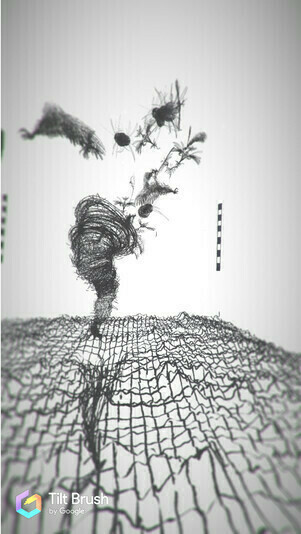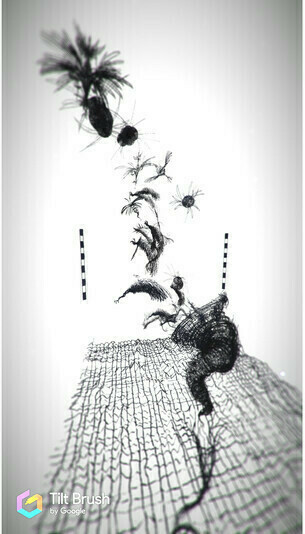BLOG/WRITING
A Brush With Virtual Unreality

A screen grab of one of my VR drawings.
Some years back, around 2018, I was invited to take part in a 'research project' at the local public art gallery to use Google Tiltbrush virtual reality at a local VR arcade. Several years later, after experimenting with novel text-to-image AI I find myself reflecting on disturbing (for me) aspects of the VR experience, of technology in general. I spent many hours down at the VR 'arcade' experimenting with drawing. Participating artists weren't paid for their work, but received 300 dollars I believe it was, for 'engaging the public' at an art opening for 'Constant Change' at the gallery. As a working artist, I insisted that my 'actual' work, which was printmaking, also be included in the exhibition alongside the virtual. As well I suggested the other artists be able to do the same. As well as the AI artists, in the main gallery a MFA graduate had an exhibition which consisted of perimeter wall painting of what might be large pixels suggesting a digital environment and in the middle of the gallery a circle of electrical cords with a vacuum cleaner robot operating with a dog bowl on top. The artist wept during her art talk. As well children were exhibiting in the gallery under the title of 'Calling All Robots'. These were young students in a robotics program. All artists gave a short talk which was printed. No one seemed to have any great concern about the technology. Here's my talk which I've edited in a bit of what I took out for brevity.
As someone trained in and deeply committed to a skill of the eye, mind and hand (drawing) I'm probably more suspicious than most of the benefits of excessive technology. I've nevertheless been curious enough to casually follow developments of the last few decades in both 3D modelling and more recently 'virtual' drawing and painting. So it was a fortunate and welcome opportunity to experiment briefly with VR drawing thanks to Matt Adamson of VRSpaces and the CVAG. I was pleased that curators Denise Lawson and Angela Somerset have seen fit to show examples of not just the virtual work of the artists involved in this project, but also their actual work.
Seeing and drawing in 3 dimensions was a novel experience, but not overwhelmingly so. VR did not open up a new psychic domain because drawing, whether 2D or 3D, is describing form and/or shape with points, lines and planes, so the shift from 2D to 3D was fairly seamless. Conceptually and even practically Tiltbrush drawing is not much different than drawing with pencil. A drawing on paper that employs linear perspective arguably creates a virtual space.
I wanted the 3D virtual drawing experience to be an extension of my drawing and printmaking aesthetics, styles and motifs. This precluded using colour and patently extravagant brushes. I settled on a line quality that seemed to imitate crayon. The Tiltbrush is a very coarse medium relative to traditional drawing materials and 2D digital drawing materials such as the Cintiq. Obviously this will improve in the future.
The onslaught of digital technologies in recent decades has made the mass production of images ever more frenzied, and this effects the value of images and how we experience and perceive images. This necessarily effects the perceived value of artists as well. The experience and appreciation of even relatively modern visual mediums such as theatrical film are being rapidly degraded. As film maker David Lynch has wryly observed about the degrading effect of not seeing film in a theater '...it's such a sadness that you think you've seen a film on your fucking telephone!' . We could apply the same sentiment to drawing, painting and other visual art forms. Will VR provide a deeper and more considered visual experience as a result of the spectator being able to immerse themselves in drawing or painting? Or will its capacity for endless digital replication relegate VR to the ubiquity of other profligate digital media? At the moment VR enjoys a modicum of novelty and therefore perceived value. How long before VR art joins today's interminably replicating epidemic of mass produced images? How can the working artist make a commodity of VR? The very existence of trained working artists requires what they produce images, objects and artifacts of value. Mass production, and especially digital mass production are so excessive they undermine this aspiration. Whatever existential impacts technology and constant change will have on the artist will be part of what it has in store for the future of all meaningful work, for human dignity, culture, civilization and even our survival as a species.
At the time I did not what to appear ungrateful for the three hundred dollars, the opportunity to use the VR technology and exhibit some of my prints, but I hope you can sense a tactful questioning of, and less than enthusiastic endorsement of the technology. For the most part none of the other artists or children or their teachers seemed to fundamentally question the technology and it's effects on artists specifically, and humans in general. There was a giddy enthusiasm from the participants including the gallery. In retrospect, after the fact, the whole thing seemed surreal, or at best unreal. Why throngs of children in a public art gallery? How can an adult visual discourse take place in their presence? My David Lynch quote was censored which reduced it's fucking effect. (The issue of children in art galleries will be the subject of another post). None of the children seemed to have been made aware of how robotics have in the last few decades undermined the value of human workers and caused job losses and social upheaval. Would they like their mummy and daddy replaced by robots? Like all the spectators at the opening, the children were deprived of an awareness of the negative consequences of technology that might have been provided by the artists, the gallery technocrats, parents or teachers. The show was unbalanced if not completely unhinged. A public art gallery had essentially become an advertising platform for a large tech corporation (Google) and high tech in general. I presumed the dream of the children and especially the parents was that they might one day become the highly valued well paid employees of these corporations. Certainly not to become visual artists. I was confused and even disgusted for days after the event and the experience. I found it hard to believe that a contemporary art institution and artists working in it's confines should have been reduced to such conformism and malleability to the promises of technology. It appeared that, in my own community and perhaps in general, we could no longer look to the arts or artists for sober second thought and reflection.
If you want to view David Lynch's i-phone 'commercial' click HERE.
If you'd like to see what other participating artists said about the VR experience you can still find the CVAG's page on the project HERE.


For comparison, above, a screen grab of my Tiltbrush VR drawing with an actual drypoint print I was working on at the time. I think it's fairly obvious that both images suggest the possibility of the unleashing of some kind of miasma, plague or technology which I felt was appropriate at the time.